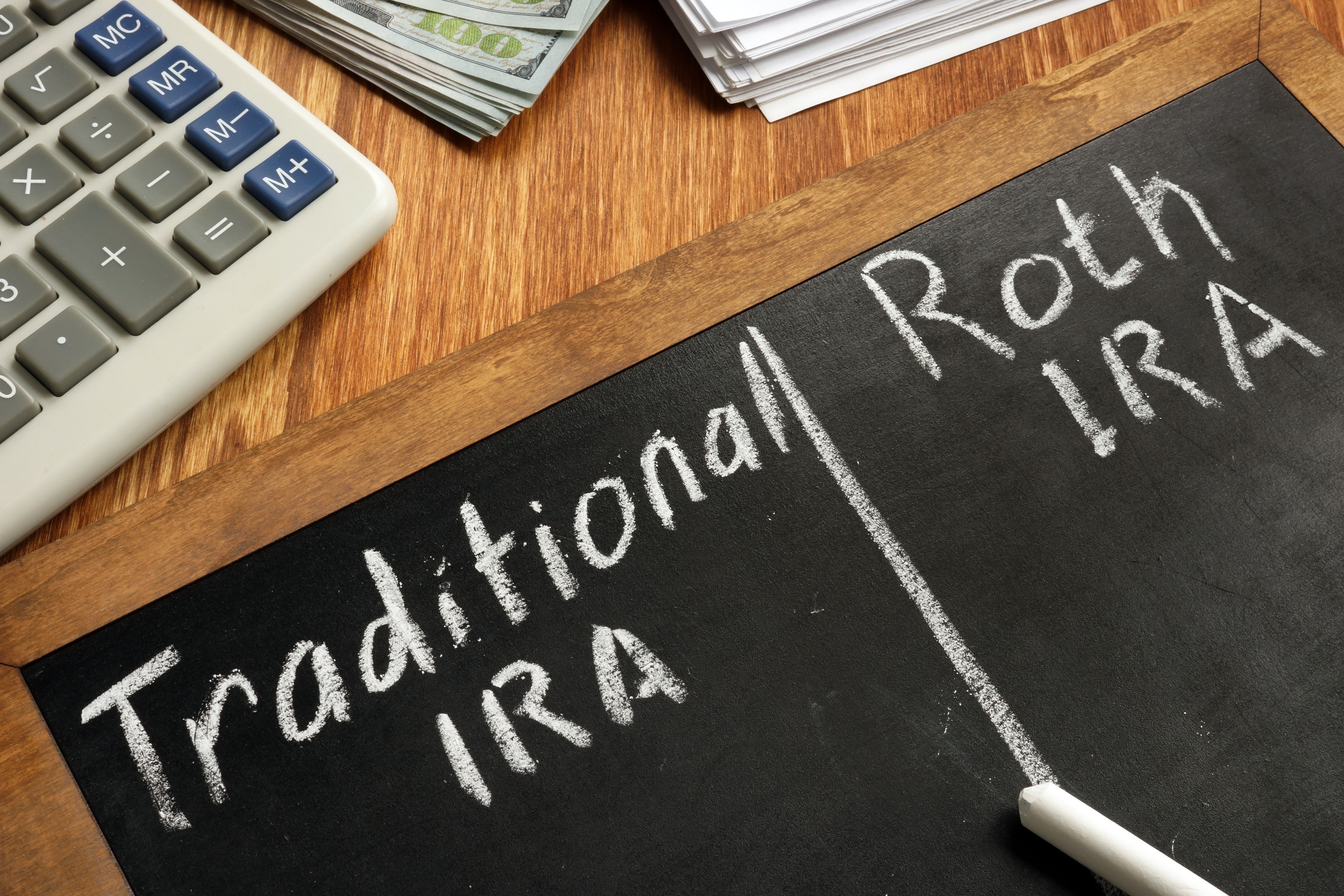Article
Roth IRA conversions: pros, cons and optimal strategies
Author(s):
Whether converting a traditional IRA to a Roth IRA would be a good move depends on your particular situation, goals and the timing involved.

In your financial reading, you’ve probably seen references to both Roth IRAs and traditional IRAs. Though both are called IRAs, the two are quite different, with different rules and tax implications.
You’ve probably also read about the ability to convert traditional IRAs into Roth IRAs. Whether this would be a good move depends on your particular situation, goals and the timing involved.
The feasibility of contributing to a Roth, after you convert to one, hinges on your current and projected income. For healthcare professionals at lower income levels, these conversions can be more feasible and beneficial than for physicians. Yet, if they use the right strategy, physicians can also benefit substantially.
The main attraction of converting to a Roth is that, because these accounts are funded with post-tax dollars (income that’s already been taxed), distributions carry no tax on withdrawals of earnings—but only if certain conditions are met (including a five-year waiting period). By contrast, every pre-tax dime withdrawn from a traditional IRA—both contributions and gains on investments—is taxed at your ordinary income tax rate.
IRS rules require holders of traditional IRAs to begin gradually withdrawing money in the form of required minimum distributions (RMDs) starting at age 72 to wind down and ultimately deplete these tax-deferred accounts. And after RMDs begin, no further contributions are allowed. On the other hand, RMDs don’t apply to Roth IRAs, and you can contribute to these accounts as long as you have earned income—i.e., wages, salaries, fees or commissions received for work you do.
Because of a relatively recent change in tax rules, Roth conversions are now irreversible, as are their tax consequences. So, it’s more important now than ever to understand the impact of a Roth conversion.
Though conversions can provide distinct benefits, they can also trigger unintended consequences that can be highly disadvantageous. Understanding these impacts is critical to making an informed decision about whether to convert a traditional IRA to a Roth. Financial planners and popular articles on the subject tend to extol the benefits of Roth IRAs without exploring downsides of Roth conversions. Also underemphasized are the mechanics of conversion strategies, based on individuals’ particular circumstances.
Here are some points to think about when considering whether to take this step:
- For withdrawals of gains from Roths to be tax-free, as noted above, five tax years must have passed since the account was established, whether by making an initial contribution or converting a traditional IRA. In addition, there is a 10% penalty for those under age 59½, although there are a few exceptions.
- Roth conversions typically involve tax pain-- meaning that whatever amount of a traditional IRA that you convert is treated as income in that tax year. To minimize the tax impact, it is usually best to convert in a low-income year or a year when you have high deductions reducing your taxable income, such uninsured medical expenses.
- Some conversion strategies focus on spreading out tax pain over time. If there’s a period of low-income years in sight, you may want to start converting then, and do so incrementally, one tranche of IRA assets per year. When using this strategy, it is important to remember that each tranche has its own five-year clock for eligibility to withdraw gains tax-free. Thus, when withdrawing gains, it’s critical to keep track of which tranche you converted and in what time period so you don’t inadvertently incur a big tax bill.
- Managing your tax brackets is essential. To get the most benefit out of the tax you incur with each IRA tranche converted, it is essential to exploit each tax bracket fully. For example, if converting $30,000 in assets would bump you up two or three tax brackets but $10,000 would keep you in your current bracket, then perhaps $10,000 is all you’d want to convert in that year. But if you can convert $20,000 and stay in the same bracket—or the next one up, if not too severe—you might want to convert $20,000 that year. Financial planners call this practice filling out your brackets.
- Even if you spread out your conversion over multiple years and manage your brackets strategically, it could take more than a decade for the benefits of conversion—tax-free investment gains—to accrue to the point where they outweigh the tax costs involved. So, it is important to take into account your health and age to estimate whether you would derive a net benefit from converting.
- IRS rules prohibit Roth contributions from individuals with annual earned incomes of $144,000 and up, and for married couples filing jointly of $214,000 and up. This is why financially adroit physicians sometimes establish a Roth and contribute to it early in their careers, while they are still below this ceiling. Later in their careers, this income ceiling prohibits most physicians from contributing. However. they might be able to convert in the tax year after the year they retire or after they begin winding down their practices - if pre-retirement has lowered their incomes below the ceiling.
In this situation, a viable strategy might be to convert the year after retiring, while delaying the start of retirement income streams, such as Social Security (which must be claimed by the age of 70) and any pensions until the year after completing conversions. Thus, even high-earning physicians could not only qualify for a Roth, but could also achieve a much lower tax bracket in the first year of a conversion process, and keep their bracket low while converting subsequent tranches. For high earners, this period between retiring and the beginning of retirement income streams is sometimes referred to as the golden zone for Roth conversions.
- Physicians and other high earners whose income levels disqualify them for Roth IRAs may be able convert their 401(k) accounts to Roth IRAs while they’re still working by executing a backdoor conversion, assuming that their employer’s 401(k) plan rules permit it. This potentially highly tax-advantageous conversion method involves complicated yet completely legal maneuvers that enable high earners to get around income limits on Roth contributions.
- To keep from exacerbating the tax impact of a traditional IRA-to-Roth conversion, it’s not advisable to pay this tax with money from the IRA. Doing so defeats the purpose, because the goal is to get as much of your IRA’s value into a Roth as possible to protect future gains from taxes. It’s usually best to take funds to pay taxes from a nonqualified account.
- An IRA-to-Roth conversion for estate-planning purposes is often a good idea for high earners, such as physicians. The federal lifetime gift and estate tax exemption is currently $12.06 million per person in 2022 (for married couples filing jointly, twice that amount). Estates below this size carry no estate tax for heirs. This exemption is scheduled to decline to $5 million (adjusted for inflation) at the end of 2025, but it might be extended, or one considerably higher might be set, before then.
If your estate’s value is close to this limit, completing a Roth conversion might be advisable, because paying the taxes would reduce the size of your estate, possibly helping to keep it below the exemption amount and thus sparing your heirs the burden of estate tax.
Moreover, inheriting a Roth instead of a traditional IRA holds significant other tax advantages for heirs, especially surviving spouses. By becoming the account holder through what’s known as a spousal transfer, spouses become subject to the rules for new accounts: gains cannot be withdrawn tax-free for five years, and account holders must be at least 59½ to avoid a tax penalty on these withdrawals. But after that, the account is treated as their own originally. There are no RMDs, and they can keep the account for life and leave it to their heirs. These heirs have 10 years to distribute all the account’s assets—to liquidate them and withdraw all the money, tax free.
This is also required of non-spouse heirs who inherit your Roth. Beneficiaries who receive traditional IRAs also have 10 years to distribute assets, but they must pay taxes on these distributions. For those inheriting a large IRA, the 10-year limit can mean a decade of much higher tax brackets.
To give your both spouse and non-spouse heirs these advantages, you will probably have to wait until you retire to convert, assuming that it is feasible based on your earned income.
- If your estate’s value is well under the exemption amount, and you’re planning to leave your traditional IRA to an heir, converting it to a Roth first might or might not be a good idea. Paying the tax would mean leaving your heir less. But if your beneficiary for the Roth is your spouse, it might be worth it for you to pay the conversion tax because of the significant tax advantages of Roths for spouses.This is especially true when inheriting accounts that have appreciated substantially over time.
If the heir is your grown child and you leave him or her a traditional IRA instead of a Roth, the taxes on distributions might be a lot lower than yours depending on the child’s tax bracket.
- If you are on Medicare the year that you convert a traditional IRA to a Roth, you should be aware that the resultant jump in ordinary income may increase your monthly Medicare premiums, possibly significantly. These increases would start in January in the calendar year after the conversion and would continue through that entire year. So it's a good idea to include this factor in your calculations of costs versus benefits. Of course, this is more of a consideration for lower earners than higher ones, such as physicians.
By fully understanding the impacts of a Roth IRA conversion on your current and anticipated financial picture, you can make an informed decision about whether to take this step and, if so, how and when.
David Robinson, a CERTIFIED FINANCIAL PLANNER™ professional, is a director and senior wealth advisor with Mariner Wealth Advisors in the firm’s Phoenix office. He provides wealth planning services and creates custom financial plans to help clients grow and protect wealth, manage taxes and identify insurance solutions. He also prepares clients for retirement and manages estate plans. Prior to joining Mariner Wealth Advisors, he was CEO of Robinson, Tigue and Sponcil, an SEC-registered advisory firm in Phoenix.





